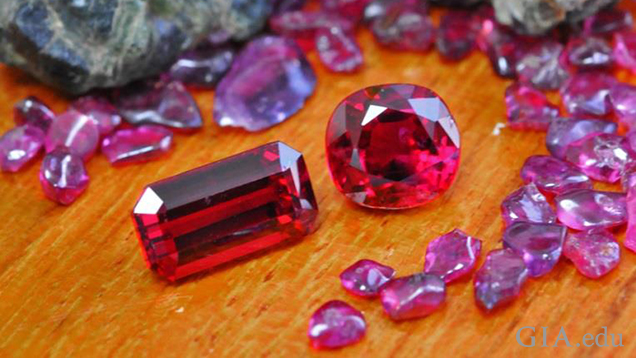A Study of Rubies from Cambodia and Thailand
August 7, 2017

Although miners have exploited ruby deposits around the Thai-Cambodian border for more than a hundred years, activity was most intensive between the 1960s and 1990s. This period coincided with a military coup in Myanmar (Burma) that made that country’s gem deposits largely inaccessible to world markets. As a result, Thailand was ideally placed to take on the mantle of the world’s premier commercial ruby source. Later in the 1990s, the Thai-Cambodian deposits became depleted and new ruby sources elsewhere came on stream. Since then, activity has declined and most mines are abandoned. Although current production is sporadic, gems from these once commercially-important deposits are present in the marketplace and in jewelry.
A new report from the GIA Laboratory in Bangkok, ‘A Study of Rubies from Cambodia and Thailand’ characterizes gems from these once prolific deposits. This study used 41 purplish-red ruby samples obtained by GIA’s Field Gemology Department in previous field expeditions: 34 from Pailin, Cambodia and 7 from Chanthaburi-Trat. The samples were fashioned to optimize them for LA-ICP-MS chemical analysis, UV-Vis-NIR and FTIR spectroscopy, and inclusion studies using microscopy and Raman spectroscopy.
Thai rubies are associated with alkali-basalt deposits in Chanthaburi, Trat and Pailin. These basalt-related gems have a very high iron (Fe) content and very low fluorescence as a consequence. Due to their high Fe content, Thai-Cambodian rubies typically have a purplish aspect, and UV-Vis-NIR spectra show a combination of both chromium and iron chromophores. To remove this purple aspect, and heal any potential fractures, rubies from these deposits are routinely heat-treated.
Minerals like diopside, negative crystals surrounded by fluid fingerprints or thin films, naturally-healed fractures, and intersecting polysynthetic twinning planes with growth tubes are among these rubies most distinctive internal characteristics. LA-ICP-MS analysis showed that comparison of gallium, magnesium, and vanadium content with the trace element chemistry of iron-rich rubies from amphibolite-related deposits is helpful for origin determination.
The authors suggest a combination of techniques—trace-element chemistry and microscopy—can readily separate Thai-Cambodian rubies from Kenyan basalt-related rubies and those originating in amphibole-related deposits.
.jpg)


